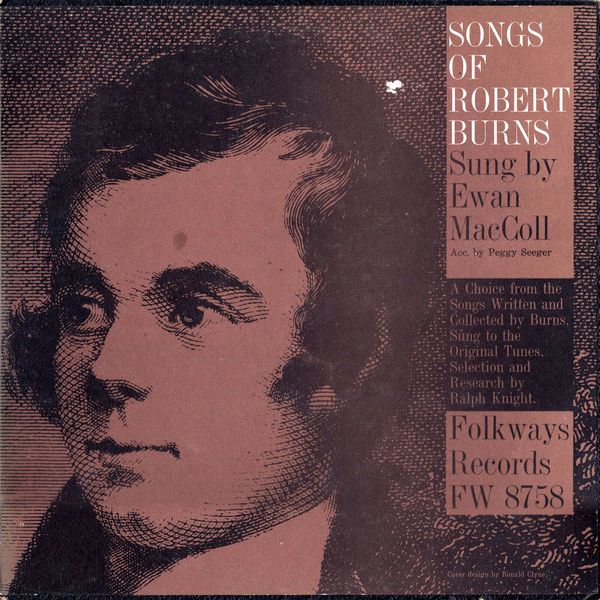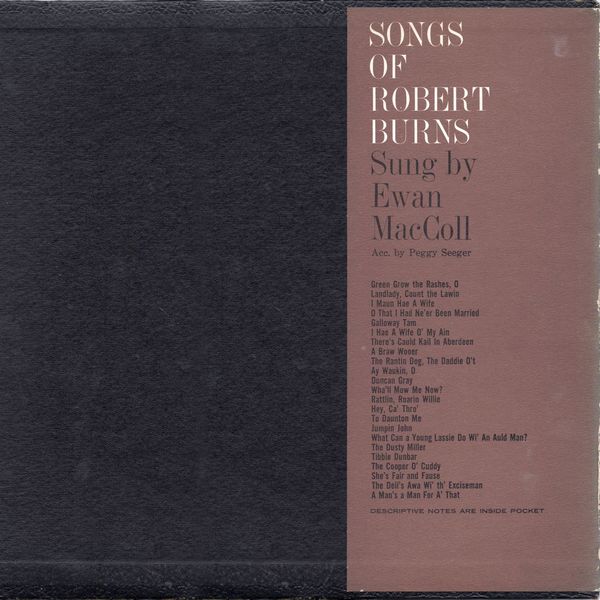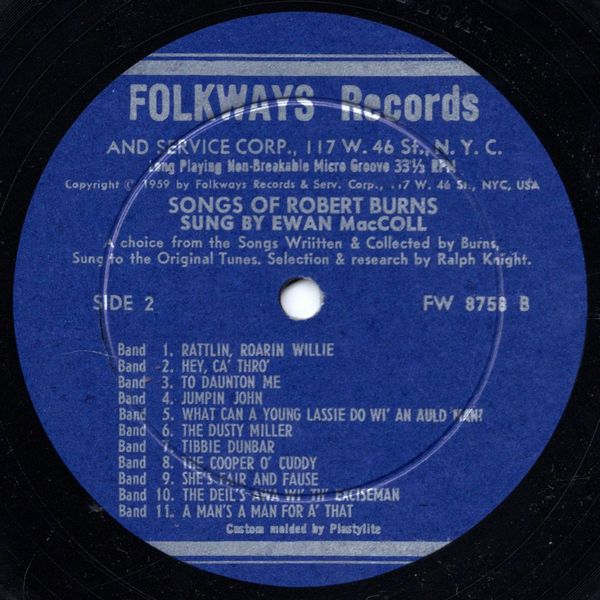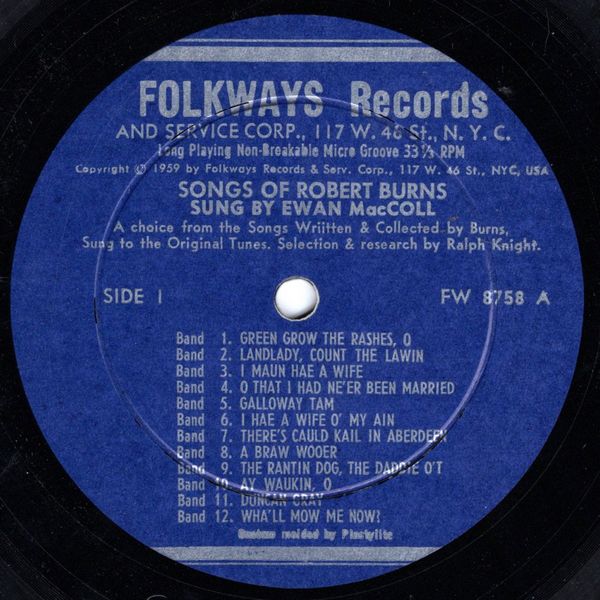

 |


 |
Sleeve Notes
Introduction and notes on the songs by Ralph Knight
Robert Burns as a Song-Writer
From earliest childhood Robert Burns was enchanted by the songs, ballads and dances current in his native Ayrshire and among the people whom he met later in his travels about Scotland. This rich music, of mysterious, elusive cadence, wild and beautiful, formed the foundation and source of the great poet's work in song. It may be said, in fact, that Burns's unique greatness lies precisely in his having so completely merged his own personality with that of the Scottish people as expressed in their music.
He took songs and dance music wherever they could be found — from his memory going back to his mother's singing, from friends who sang and played, and from music collections. His touchstone of merit was always that the music and words should have been long tested by "Nature's Judges, the Common People." Tirelessly collecting, writing, patching up, Burns finally created a national treasury of song for Scotland, leaving his country a gift the like of which no other nation has ever received from a poet.
With Burns, the first step toward creating a song was to learn the tune perfectly. This wasn't always easy because Burns's technical knowledge of music was rather rudimentary and the Scottish tunes are frequently highly irregular; but, with practice, his ear grew so fine that he was able to guide the work of professional musicians.
Having mastered the tune, Burns would then compose words to fit. When traditional words existed, he was careful to preserve them, frequently doing little more than patching up a bit.
In the early years Burns pursued this work for pleasure, publishing almost nothing of the songs in his first books of verse. But in the spring of 1787, in his twenty-ninth year, when he had collected or composed about forty songs, he was invited by an editor, James Johnson, to contribute to a collection, The Scots Musical Museum, and this event was to lead to the formation of a comprehensive plan to collect and prepare for the press every existing Scottish song. The first volume of the Museum was then nearly ready for the press. Burns immediately contributed two songs and quickly assumed the work of chief editor. Under his guidance, the Museum, originally projected as two volumes of one hundred songs each, grew to six volumes. Of the six hundred songs finally published, at least two hundred were contributed by Burns.
Later, in 1792, Burns was again invited to contribute to another work, A Select Collection of Original Scottish Airs. This work permitted Burns but little leeway because its editor, George Thomson, a shallow dilettante who believed himself to be a keen Judge of music and poetry, often overruled Burns's views. Thomson's real aim was to Anglicize and emasculate Scottish song in order to tame it for salon performance. In a series of remarkable letters, Burns fought out the question with Thomson, striving to preserve the great oral tradition against Thomson's ruinous alterations and needless ornamentations. Of course Burns never changed Thomson's views, but, in the letters, left us a record of his own.
No effort has been spared to see to it that the songs on this recording conform to Burns's way in Scottish song. Music and words are drawn from the best sources. In cases where there may have been a doubt regarding text or tune, a most careful reconstruction of Burns's intentions has been made by combing the sources. Most sure taken from the Museum in its original printing; others are based upon the work of the great scholar, James C. Dick, whose book, The Songs of Robert Burns (London, 1903), is the most authentic printing so far of Burns's work in song. One is from a more rare, but completely reliable, source. They range from songs reported from the tradition and perhaps only slightly touched up by Burns, such as "There's Cauld Kail In Aberdeen," to wholly original creations of Burns on traditional tunes, such as the delightful "The Rantin Dog, The Daddie O't."
In Ewan MacColl, the immensely talented Scottish folk singer, actor and playwright, we have an artist who is superbly fitted to sing Burns's songs. Like the poet, MacColl grew up in the singing tradition of Scotland, learning the style from his parents. Again like Burns, he has gone on to work deeply in folk music. His warm voice communicates Burns's songs with living force. In this recording the listener can truly gain much insight into the passionate heart of "the world's greatest poet of the common people."
Ralph Knight
Green Grow The Rashes, O — Burns knew "the merry old tune," "Green Grow The Rashes, O", as a 'bawdy song that had been long current in Scotland. When Jean Armour delivered a set of twins from her first pregnancy, Burns, in an excess of pride and happiness, sent a bawdy version of his own to a friend to signalize the event.
Landlady, Count The Lawin (Tune: Hey tutti taiti) — "I have met the tradition universally over Scotland … that this air was Robert Bruce's march at the battle of Bannockburn," Burns wrote about "Hey tutti taiti," but there is no evidence to support his belief. Burns, however, did use this old dance tune as the air for his song of Bruce's address to his troops at Bannockburn, "Scots, Wha Hae," and for this drinking song.
I Maum Hae A Wife (Tune: Buy Broom Besoms) — "Buy Broom Besoms," obviously having it origin as a broom-hawker's song, was a well-known tune in Burns's time. Apparently Burns did little more with the words than report them:
O That I Had Ne'er Been Married (Tune: Crowdie) — Burns loved his children passionately and lived with deep fears that he would die and leave then penniless and helpless. "I cannot describe to you," he wrote to a friend, "the anxious, sleepless hours these ties frequently give me. I see a train of helpless little folks: me, & my exertions, all their stay; & on what a brittle thread does the life of man hang! If I am nipt off … what would become of my little flock!" Then, "in order to leave talking of the matter so gravely," he quotes the chorus of the old song, "Crowdie." The first stanza and chorus are traditional, as is the tune; the second stanza is Burns's.
Galloway Tam — "Galloway Tam," again, was an old song, little changed by Burns.
I Hae A Wife O' My Ain — This proud, brave song was written by Burns to an old dance tune shortly after his marriage to Jean Armour.
There's Cauld Kail In Aberdeen (Tune: Cauld Kail) — These words to the well-known air, "Cauld Kail," were collected by Burns from singing current in his day.
A Braw Wooer (Tune: The Lothian Lassie) — There was no hint in any earlier work for this rollicking narrative, though the tune was old and "a great favorite of mine," Burns wrote.
The Rantin Dog, The Daddie O't (Tune: Whare Wad Bonie Annie Lie) — "I composed this song pretty early in life and sent it to a young girl, a very particular acquaintance mine, who was at that time under a cloud," so Burns wrote of this merry masterpiece. No one now knows whether the "young girl … under a cloud," who would sing these words, was Elizabeth Paton, the mother of Burns's first child, or Jean Armour.
Ay Waukin, O — Just how much this traditional song was touched up is not known.
Duncan Gray — This is one of three sets of words which Burns wrote to the tune of a widely known bawdy song of the same title.
Wha'll Mow Me Now? (Tune: Comin Thro' The Rye) — "Coming Thro' The Rye" was an old bawdy song that Burns once altered for general publication. But on another occasion he wrote a completely new set of verses, which, though bawdy, express a profound moral aim.
Rattlin, Roarin Willie — In "Rattlin, Roarin Willie" Burns added, a final stanza to an immensely popular traditional song. The stanza honors "one of the worthiest fellows in the world, William Dunbar … " Dunbar was presiding officer of the Crochallan Fencibles, an Edinburgh club of convivial bachelors of which Burns was a leading member.
Hey, Ca' Thro' — The four towns mentioned in the first stanza of this powerful work song are small fishing villages on the south coast of Fife. Burns is believed to have collected this song on a trip near there; it had never appeared in print before Burns reported it.
To Daunton Me — "To Daunton Me" was an old Jacobite song; Burns was attracted to the tune, which is now thought to have been of English origin even though well acclimated in the Scottish singing tradition, and wrote these fresh words for it.
Jumpin John — "Jumpin John" is a very old tune. It is thought that Burns merely patched up old words.
What Can A Young Lassie Do Wi' An Auld Man? (Tune: What Shall I Do With An Auld Man) — These words were suggested to Burns on little more than a hint found in an old title and tune.
The Dusty Miller — A fragment from the tradition, touched up.
Tibbie Dunbar (Tune: Johnny McGill) — Burns reported that the tune of "Tibbie Dunbar" was said "to be the composition of John McGill, fiddler in Girvan; who called it after his own name." It was probably older, however, and may be of English origin. The words are Burns's.
The Cooper O' Cuddy (Tune: Bab At The Bowster) — This lively song was written to be sung to the tune of a famous dance game, "Bab At The Bowster," which, Burns wrote, "is to be met with everywhere."
She's Fair And Fause (Tune: The Lads Of Leith) — "She's Fair And Fause" is believed to have been written about a friend's unlucky love affair.
The Deil's Awa Wi' Th' Exciseman (Tune: The Hemp-dresser) — In the last years of his life, while living in the town of Dumfries, Burns was an exciseman, a government officer who inspects and rates articles liable to taxation. An old tune gave Burns the idea for this wildly farcical assault on tax collectors. It is said that Burns sang it at a dinner of fellow officers.
A Man's A Man For A' That (Tune: For A' That) — "A great critic … on songs says that love & wine are the exclusive themes for song-writing. The following is on neither subject & consequently is no Song; but will be allowed, I think, to be two or three pretty good prose thoughts, inverted into rhyme." Thus Burns wrote in sending along this song to George Thomson. Fortunately Burns followed his impulses, rather than the strictures of the "great critic," and found political matter also to be a suitable theme for songs.